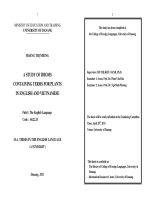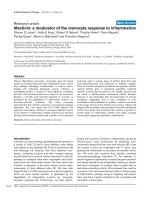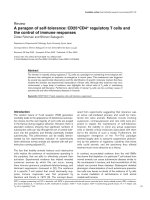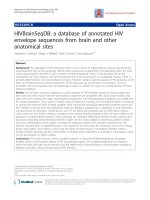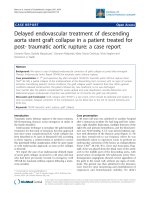Alexandra y aikhenvald classifiers a typology of noun categorization devices (oxford studies in typology and linguistic theory)
Bạn đang xem bản rút gọn của tài liệu. Xem và tải ngay bản đầy đủ của tài liệu tại đây (26.32 MB, 562 trang )
CLASSIFIERS
OXFORD STUDIES IN TYPOLOGY AND LINGUISTIC
THEORY
SERIES EDITORS: Ronnie Cann, University of Edinburgh, William Croft, University of
Manchester, Mark Durie University of Melbourne, Anna Siewierska, University of
Lancaster
This series offers a forum for orginal and accessible books on language typology
and linguistic universals. Works published will be theoretically innovative and
informed and will seek to link theory and empirical research in ways that are
mutually productive. Each volume will also provide the reader with a wide range
of cross-linguistic data. The series is open to typological work in semantics, syntax,
phonology, and phonetics or at the interfaces between these fields.
Published:
Indefinite Pronouns
Martin Haspelmath
Intransitive Predication
Leon Stassen
Classifiers: A Typology of Noun Categorization Devices
Alexandra A. Aikhenvald
Anaphora
Yan Huang
In preparation:
The Noun Phrase
Jan Rijkhoff
Double Object Constructions
Maria Polinsky
CLASSIFIERS
A Typology of Noun
Categorization Devices
ALEXANDRA Y. AIKHENVALD
OXFORD
UNIVERSITY PRESS
OXFORD
UNIVERSITY PRESS
Great Clarendon Street, Oxford 0x2 6DP
Oxford University Press is a department of the University of Oxford.
It furthers the University's objective of excellence in research, scholarship,
and education by publishing worldwide in
Oxford New York
Athens Auckland Bangkok Bogota Buenos Aires Calcutta
Cape Town Chennai Dar es Salaam Delhi Florence Hong Kong Istanbul
Karachi Kuala Lumpur Madrid Melbourne Mexico City Mumbai
Nairobi Paris Sao Paulo Singapore Taipei Tokyo Toronto Warsaw
and associated companies in Berlin Ibadan
Oxford is a registered trade mark of Oxford University Press
in the UK and certain other countries
Published in the United States
by Oxford University Press Inc., New York
© A. Y. Aikhenvald 2000
The moral rights of the author have been asserted
Database right Oxford University Press (maker)
First published 2000
All rights reserved, No part of this publication may be reproduced,
stored in a retrieval system, or transmitted, in any form or by any means,
without the prior permission in writing of Oxford University Press,
or as expressly permitted by law, or under terms agreed with the appropriate
reprographics rights organizations. Enquiries concerning reproduction
outside the scope of the above should be sent to the Rights Department,
Oxford University Press, at the address above
You must not circulate this book in any other binding or cover
and you must impose the same conditions on any acquirer
British Library Cataloguing in Publication Data
Data available
Library of Congress Cataloging in Publication Data
Data applied for
ISBN 0-19-823886-X
1 3 5 7 9 1 08 6 4 2
Typeset in Times
by J&L Composition Ltd, Filey, North Yorkshire
Printed in Great Britain
on acid-free paper by
Biddies Ltd, Guildford & King's Lynn
For Bob, okojibotee
This page intentionally left blank
Preface
This book aims at providing a cross-linguistic analysis of noun classification
systems across the languages of the world, also dealing with a variety of
other problems such as the morphological status of the markers of these
categories, agreement phenomena, and the syntactic and semantic
classification of adjectives and numbers. It is generally accepted that
linguistic categorization of nouns is a reflection of human mind and culture.
The present study thus has far-reaching implications for cross-cultural as
well as cross-linguistic studies of human cognition, and will provide new
insights concerning the mechanisms by which human language functions.
Languages with extensive systems of noun classification devices,
especially those which combine classifiers and genders, present a true
challenge for the typologist. My first encounter with these unusual systems
was through fieldwork on Tariana and Baniwa, two closely related North
Arawak languages spoken in Northwest Amazonia. The more I worked on
the topic, the more exotic and unusual systems I encountered, especially
among little-known South American languages, and languages of the
South Pacific. This book came into being as an attempt to integrate these
systems into a cross-linguistically based typological framework.
This study is an up-to-date introduction to the field, and will be of value
not only to a wide variety of linguists and linguistic students but also to
anthropologists, cognitive psychologists, and philosophers who are interested
in language and the mind. It can be used both as a sourcebook for further
typological studies, and as a textbook. The discussion in the book is in
terms of basic linguistic theory, the framework of linguistic analysis in
terms of which most grammars are cast, and in terms of which significant
typological generalizations are postulated. (I have avoided using any of the
more specific formalisms, which come and go with such frequency.)
Some terminological clarifications are in order. First, my conception of a
lexical entry for 'noun' roughly corresponds to the notion of 'lexeme' as
outlined by Lyons (1977 vol. 1: 19). Second, throughout the book 'linguistic
categorization of a noun' is used to mean 'linguistic categorization of the
referent of a noun', just as in many linguistic usages 'human noun' is a short
way of saying 'noun with a human referent'. Third, the term 'noun categorization' is used here in a sense close to the 'noun classification' (cf. Craig
1986a; Derbyshire and Payne 1990) or 'nominal classification' (cf. Harvey and
Reid 1997) employed by other authors. The term 'classifier system' refers to a
grammatical system of noun categorization device(s) in a particular language.
viii
Preface
In order to limit the book to a reasonable size, I have only been able to
refer to a portion of the available literature. There are many other sources
that I have consulted, which only provide additional exemplification for
points that are already well covered. When a language is introduced for the
first time, its genetic affiliation and the source of information on it are
given in parentheses; further on, this information is only repeated where
relevant. Examples, tables and diagrams are numbered separately within
each chapter.
The orthography used in the examples and language names follows that
of the sources (unless indicated otherwise).
A study like this could only be definitive when good and thorough
descriptions have been provided for most of the world's languages; we are
at present a long way from this situation. Nevertheless, I hope that this
study will provide a framework within which fieldworkers and typologists
will be able to work, and which can be amended and adjusted as new data
and new insights emerge.
It is my hope that this book will encourage people to study noun
classification devices, especially in little-known or undescribed languages,
going out into the field and documenting languages threatened by extinction (before it is too late to do so).
Acknowledgements
My gratitude goes to all those native speakers who taught me their
languages and their unusual classifier and gender systems: Candido, Jose,
Jovino, Graciliano, and Olivia Brito (Tariana); Humberto Baltazar and
Pedro Angelo Tomas (Warekena); the late Candelario da Silva (Bare);
Afonso, Albino and Joao Fontes, Celestino da Silva, Cecilia and Laureano
da Silva, and the late Marcilia Rodrigues (Baniwa); the late Tiago Cardoso
(Desano, Piratapuya); Alfredo Fontes (Tucano); Marilda and Carlito
Paumari (Paumari); Raimunda Palikur (Palikur); Simone Nientao
(Tamachek) and—last but not least—Pauline and James Laki (Manambu).
I am also indebted to students in the Federal University of Santa Catarina,
Brazil, and in the Australian National University. I learned a lot from
working with Rute Amorim, Lilias Chun, Christiane Cunha de Oliveira,
Tim Curnow, Michael Dunn, Catriona Hyslop, Dorothy Jauncey, Yunseok
Lee, Eva Lindstrom, Peita Littleton, Rina Marnita, Silvana Martins,
Kazuko Obata, Kristina Sands, Eva Tatrai, Angela Terrill, Simoni
Valadares, and Jacki Wicks. My warmest thanks go to Silvana and Valteir
Martins and Lenita and Elias Coelho de Assis, without whose friendship
and assistance a great deal of my fieldwork would have been impossible.
Special gratitude goes to Diana Green, who revealed to me the beauty of
genders and classifiers in Palikur.
I am most grateful to those people who helped me by sending copies of
their papers, answering my questions and commenting on various parts of
this manuscript: Jose Alvarez, Mengistu Amberber, Felix Ameka, Peter
van Baarle, Janet Barnes, Candida Barros, Edith Bavin, Walter Bisang,
Kim Blewett, Paula Boley, John Boyle, Friederike Braun, Lea Brown, Bill
Callister, Lyle Campbell, Eugene Casad, Meiyun Chang-Smith, Adam
Chapman, Shirley Chapman, Hilary Chappell, Helen Charters, Bernard
Comrie, Bob Conrad, Grev Corbett, Tim Curnow, Des Derbyshire, Connie
Dickinson, Tony Diller, Gerritt Dimmendaal, Mark Donohue, Nancy
Dorian, Mark Durie, Tom Dutton, Nora England, Nick Evans, Cindi
and Jim Farr, Bill Foley, Lys Ford, David Foris, Paul Frank, David Gil,
Cliff Goddard, Elsa Gomez-Imbert, Ian Green, Rebecca Green, Colette
Grinevald (Craig), Geoff Haig, Mark Harvey, Rie Hasada, Bernd Heine,
Debbie Hill, Chu-Ren Huang, Rodney Huddleston, Suanu Ikoro, Liisa
Jarvinen, Jae Jung Song, Aleksandr J. Kibrik, Harold Koch, Antonina I.
Koval', Randy LaPolla, Jason Lee, Jennie Lee, Jeff Leer, W. P. Lehmann,
Adrienne Lehrer, Frank Lichtenberk, Eva Lindstrom, Elizabeth Lobel,
x
Acknowledgements
Ivan Lowe, Harriet Manelis-Klein, Jack Martin, Marianne Mithun,
Catherine McGuckin, Ulrike Mosel, Otto Nekitel, Bee Chin Ng, Johanna
Nichols, Masayuki Onishi, Patricia Pacioni, Helma Pasch, Peter Paul,
Andrew Pawley, David Payne, Vladimir Plungian, Bill Poser, Kostantin
Pozdnjakov, Bruce Rigsby, Phil Quick, Susan Quigley, Katya Rakhilina,
Henri Ramirez, Nick Reid, Keren Rice, Aryon Rodrigues, Malcolm Ross,
Carl Rubino, Alan Rumsey, Filomena Sandalo, Risto Sarsa, Hansjakob
Seiler, Lucy Seki, Gunter Senft, Beatriz and Rodolfo Senn, Gi-Hyun Shin,
Tim Shopen, Edgar Suter, Chad Thompson, Irina Toporova, Joe Tsonope,
Ione Vasconcelos, Alejandra Vidal, Tiit-Rein Viitso, Viktor A. Vinogradov,
Julie Waddy, Bruce Waters, Laurel Watkins, Anna Wierzbicka, Mary Ruth
Wise, Stephen Wurm, and Roberto Zavala.
I am most grateful to those who read through the whole draft of this book,
or parts of it, and provided comments, corrections and ideas—Peter Denny,
Nancy Dorian, David Foris, Cliff Goddard, Nikolaus Himmelmann, Frank
Lichtenberk, Edith Moravcsik, Patricia Pacioni, Helma Pasch, Doris Payne,
Nick Reid, Malcolm Ross, Fritz Serzisko, and Roberto Zavala. Invaluable
comments on almost every page came from R. M. W. Dixon, Keith Allan,
Walter Bisang, Lyle Campbell, Gerritt Dimmendaal, Mark Durie, Ulrike
Mosel, and Gunter Senft.
My deepest gratitude goes to the SIL Library in Ukarumpa, and to Paul
Frank, the director of the Summer Institute of Linguistics (Colombia),
who provided me with invaluable materials on languages of Papua New
Guinea and Colombia respectively.
I am also grateful to the members of Eesti Noorte Grupp of Canberra—
Reet Bergman, Krista Gardiner, and Reet Vallak—who helped me realize
that communicating in a language without genders or classifiers can be
great fun.
Suzanne Kite carefully read through several drafts of this book and
corrected it with her usual skill, dedication, and good humour. Thanks
are equally due to her.
Jennifer Elliott provided a wonderful working atmosphere at the
Research Centre for Linguistic Typology. This book would have been
scarcely possible without her.
Plea
This book is far from being the last word on noun categorization devices. I
welcome reactions, counterexamples, new ideas and data, to further
develop, refine, and improve the generalizations put forward here. Please
send them to me at Research Centre for Linguistic Typology, La Trobe
University, Bundoora Vic., 3083 Australia.
This page intentionally left blank
Contents
List
List
List
List
of
of
of
of
Maps
Tables
Diagrams
Abbreviations
xx
xxi
xxiv
xxv
1. Preliminaries
1.1 General remarks
1.2 Classifiers: an illustration
1.3 Theoretical framework, data, and sources
1.4 Approaches to the typology of classifiers
1.5 Parameters for the typology of classifiers
1.6 The structure of this book
1
1
1
4
5
13
16
2. Noun Class and Gender Systems
2.1 General remarks
2.2 Properties of noun class systems
2.3 Principles of noun class assignment
2.3.1 Semantic assignment
2.3.2 Morphological assignment
2.3.3 Phonological assignment
2.3.4 Mixed principles of assignment
2.4 Noun classes and agreement
2.4.1 A working definition of agreement and
agreement properties
2.4.2 Principles of noun class agreement
2.4.3 Variability in noun class assignment and
variable agreement
2.4.4 Determining the number of noun classes in
a language
2.5 Markedness and resolution in noun classes
2.5.1 Markedness
2.5.2 Noun class resolution
2.5.3 Markedness relationships in noun classes
2.6 Realization of noun classes
2.6.1 Overt and covert noun class marking
2.6.2 Morphological realization of noun classes
2.6.3 Double marking of noun classes
19
19
20
22
22
25
25
25
28
28
31
41
45
50
50
52
54
56
57
58
63
xiv
Contents
2.7 Languages with more than one kind of noun class
2.7.1 Nominal and pronominal noun class
2.7.2 Different kinds of noun class in the same
environment
2.7.3 Languages with more than one kind of noun class:
a summary
2.8 Distribution of noun classes in the languages of the
world
3. Noun Classifiers
3.1 Properties of noun classifiers
3.2 Noun classifiers: discussion and exemplification
3.2.1 The choice of noun classifiers and the
cooccurrence of several classifiers within one
noun phrase
3.2.2 Semantic functions of noun classifiers
3.2.3 Size of inventory and degree of
grammaticalization of noun classifiers
3.2.4 Syntactic functions of noun classifiers
3.3 Noun classifiers and numeral classifiers
3.4 Realization and grammaticalization of noun classifiers
3.5 Overt noun class marking and noun classifiers
3.6 Distribution of noun classifiers in the languages of
the world
4. Numeral Classifiers
4.1 Properties of numeral classifiers
4.2 Numeral classifier constructions and morphological
realization of numeral classifiers
4.2.1 Numeral classifiers as independent lexemes
4.2.2 Numeral classifiers attached to numerals
4.2.3 Numeral classifiers attached to the head noun
4.3 Languages with more than one morphological type of
numeral classifier
4.3.1 Different types of numeral classifier in
complementary distribution
4.3.2 Different types of numeral classifier which
occur together
4.4 Problems with numeral classifiers
4.4.1 Mensural and sortal classifiers: distinguishing
classifiers from quantifying expressions
4.4.2 Incipient numeral classifiers
4.5 Distribution of numeral classifiers in the languages of
the world
67
68
70
76
77
81
81
82
82
84
84
87
90
91
92
97
98
98
101
101
105
110
112
112
113
114
114
120
121
Contents
5. Classifiers in Possessive Constructions
5.1 Categorization in possessive constructions
5.2 Possessed classifiers
5.3 Relational classifiers
5.3.1 Relational classifiers and their properties
5.3.2 Types of possession and relational classifiers
5.4 Possessor classifiers
5.5 Interaction of possessed and relational classifiers
5.5.1 Integrating relational and possessive classifiers
5.5.2 Languages with two types of classifier in
possessive constructions
5.6 Contrasting classifiers in possessive constructions
5.7 Distribution of classifiers in possessive constructions
in the languages of the world
xv
125
125
126
133
133
137
139
140
140
142
144
147
6. Verbal Classifiers
6.1 Properties of verbal classifiers
6.2 Realization of verbal classifiers
6.2.1 Classificatory noun incorporation
6.2.2 Verbal classifiers as affixes
6.2.3 Suppletive 'classificatory verbs'
6.2.4 The interaction of the three types of verbal
classifier
6.3 Verbal classifiers and syntactic function of the argument
6.4 Combinations of different types of verbal classifier
6.4.1 Different types of verbal classifier in complementary
distribution
6.4.2 Distinct systems of verbal classifiers
6.5 Distribution of verbal classifiers
149
149
149
150
152
153
7. Locative and Deictic Classifiers
7.1 The structure of this chapter
7.2 Properties of locative classifiers
7.3 Properties of deictic classifiers
7.3.1 Examples of deictic classifiers
7.3.2 Conclusions and discussion
172
172
172
176
177
181
8. Different Classifier Types in One Language
8.1 General observations
8.2 Coexisting classifier sets in different environments
8.3 Different classifier sets in the same environment
8.4 Conclusions
184
184
185
198
201
160
162
163
163
167
169
xvi
Contents
9. Multiple Classifier Languages
9.1 Noun categorization in multiple classifier languages
9.2 Multiple classifier languages and noun class agreement
on multiple targets
9.3 Fuzzy types: overlapping classifiers in multiple
environments
9.3.1 Multiple classifiers in Baniwa
9.3.2 Multiple classifiers in Tariana
9.3.3 Fuzzy types and borderline cases
10. Classifiers and Other Grammatical Categories
10.1 Classifiers and number
10.1.1 Noun classes and number
10.1.2 Number and other classifier types
10.2 Classifiers and person
10.3 Classifiers and grammatical function
10.3.1 Noun classes and grammatical function
10.3.2 Verbal classifiers and grammatical function
10.4 Classifiers and types of possession
10.4.1 Noun classes and types of possession
10.4.2 Classifiers in possessive constructions and types
of possession
10.5 Classifiers and politeness
10.6 Classifiers and declensional classes
10.7 Classifiers and verbal categories
10.8 Classifiers and deictic categories
10.9 Classifiers, derivation, and lexicon
10.10 Conclusions
11. Semantics of Noun Categorization Devices
11.1 Semantic parameters in noun categorization
11.1.1 Basic parameters of categorization
11.1.2 Additional semantic characteristics
11.1.3 Semantic relationship between a classifier and
the referent
11.2 Semantics of classifier types
11.2.1 Semantics of noun classes
11.2.2 Semantics of noun classifiers
11.2.3 Semantics of numeral classifiers
11.2.4 Semantics of classifiers in possessive
constructions
11.2.5 Semantics of verbal classifiers
204
204
228
230
230
235
240
242
243
243
249
252
255
255
257
257
258
259
260
262
263
266
266
268
271
271
271
274
275
275
275
283
286
293
295
Contents
11.2.6 Semantics of locative and of deictic classifiers
11.2.7 Semantic parameters in languages with several
different types of classifier
11.2.8 Semantic parameters in multiple classifier
systems
11.2.9 Conclusions
12. Semantic Organization and Functions of Noun
Categorization
12.1 Semantic organization and functions of classifier
systems
12.1.1 Semantic complexity in classifier systems
12.1.2 Semantic roles of classifiers
12.1.3 Discourse-pragmatic functions of classifiers
12.1.4 Applicability of classifiers and default classes
12.2 Human cognition and classifiers
12.2.1 Perceptual correlates of noun categorization
12.2.2 Cognitive mechanisms and noun categorization
12.3 Social and cultural issues in noun categorization
12.3.1 Social structure in noun categorization
12.3.2 Environment and culture in noun categorization
12.3.3 Culture-specific metaphorical extensions
12.3.4 Socio-cultural motivations for change in noun
categorization
12.4 Conclusions
13. Origin and Development of Noun Categorization Devices
13.1 Lexical sources for classifiers
13.1.1 From a noun to a classifier
13.1.2 Repeater phenomena and the origin of classifier
constructions
13.1.3 From a verb to a classifier
13.1.4 Classifiers from deverbal nominalizations
13.1.5 Classifiers of mixed origin
13.2 From a closed class to a noun categorization system
13.3 Languages with several classifier types, and the relative
age of noun categorization devices
13.4 Internal evolution of noun categorization
13.5 Grammaticalization and reanalysis in noun
categorization systems
13.5.1 Grammaticalization in the development of noun
categorization
13.5.2 Reanalysis in noun categorization
xvii
300
301
303
305
307
307
308
317
320
334
337
337
339
340
342
343
346
347
350
352
353
353
361
362
365
366
367
370
372
374
374
377
xviii
Contents
13.6 Reduction and loss of noun categorization devices
13.7 Language-external motivations for the development
and decay of noun categorization
13.7.1 Language contact and noun categorization
13.7.2 Creolization and noun categorization
13.7.3 Language obsolescence and noun categorization
13.7.4 Language-external motivations and their impact
on noun categorization
13.8 Development and loss of agreement
13.8.1 The genesis and development of agreement
13.8.2 Decline and loss of agreement
13.9 Semantic changes in noun categorization devices
13.9.1 From lexical item to classifier: principles of
semantic change
13.9.2 Further changes in noun categorization devices
13.10 Sources of noun categorization devices: a summary
14. Noun Categorization Devices in Language Acquisition and
Dissolution
14.1 Acquisition and development of noun classes
14.2 Acquisition of numeral classifiers
14.3 Dissolution of noun classes and of numeral classifiers
14.4 Conclusions
15. Conclusions
15.1 Properties of classifier types
15.2 Cooccurrence of classifier types and multiple classifier
languages; prototypes and continua
15.3 Prospects for future studies
379
382
383
388
389
391
391
391
398
400
401
407
411
413
413
417
422
423
425
425
432
434
Appendix 1. Noun Categorization by Means Other than
Classifiers
Appendix 2. From Nouns to Classifiers: Further Examples of
Semantic Change
(A) Body parts as sources for classifiers: semantic
extensions
(B) Sources for shape-based numeral classifiers
Appendix 3. Fieldworker's Guide to Classifier Languages
442
446
447
References
452
List of Languages
List of Language Families, Linguistic Areas, and Proto-languages
489
504
436
442
Contents
Index of Languages, Linguistic Areas, and Language Families
Index of Authors
Subject Index
xix
509
519
525
List of Maps
1. Distribution of noun classes and genders in the languages
of the world
2. Distribution of noun classifiers in the languages of the world
3. Distribution of numeral classifiers in the languages of the
world
4. Distribution of classifiers in possessive constructions in the
languages of the world
5. Distribution of verbal classifiers in the languages of the world
78
96
122
148
170
List of Tables
1.1
1.2
1.3
1.4
Shopping list in Japanese
Differences between noun classes and classifiers
Classifiers, their morphological realization, and semantics
Classifiers and their functions
2
6
7
8
Semantics of noun classes in Proto-Bantu
Semantic features for the gender assignment of inanimate nouns
in Cantabrian Spanish
2.3 Inflection and derivation
2.4 Gender marking in Rumanian
2.5 Gender marking in Telugu
2.6 Gender agreement in Khinalug
2.7 A fragment of the Russian nominal paradigm
2.8 Noun classes in Ingush
2.9 Noun classes in Ndali
2.10 'Pronominal' and 'nominal' noun class systems
2.11 Ka-class assignment in Paumari
2.12 Two types of noun class (genders) in Mba
24
2.1
2.2
27
30
46
46
47
48
49
64
68
73
75
4.1
4.2
4.3
4.4
4.5
4.6
Numeral classifiers used with humans in Assamese
Numeral classifiers in Telugu
Classifiers fused with numerals in Kusaiean
Numeral classifiers in Nivkh
Numeral classifiers in Warekena
Numeral classifiers in Squamish
102
108
108
109
109
110
5.1
5.2
5.3
5.4
5.5
5.6
Possessed classifiers in Panare
Systems of two relational classifiers
A system of relational classifiers in Boumaa Fijian
Sample of classifiers in Puluwat
Differences between possessed and relational classifiers
Relational, possessed, and possessor classifier; a comparison
128
134
134
141
145
146
6.1
6.2
6.3
6.4
6.5
6.6
6.7
6.8
6.9
Mescalero Apache classificatory verb categories
Classificatory verbs in Ojibway
Classificatory verbs in Ika
Examples of the use of 'give' in Mescalero Apache
Classificatory verbs in Koyukon: an example
Classificatory verbs in Nevome
Classificatory verbs in Enga
Classificatory verbs in Ku Waru
Verbal classifiers in Waris
155
155
156
157
157
158
159
159
166
xxii
List of Tables
6.10 Classificatory verbs in Waris
6.11 Affixed verbal classifiers in Koyukon
167
167
7.1
7.2
7.3
7.4
175
178
181
182
Locative Classificatory suffixes in three Carib languages
Article classifiers in Ponca
A sample of demonstratives in Proto-Guaicuruan
Deictic classifiers in Eskimo
8.1
8.2
8.3
8.4
8.5
8.6
8.7
8.8
8.9
Noun classes and noun classifiers in Ngan'gityemerri
Classifiers in Mokilese
Numeral classifiers in Akatek
Noun classifiers in Akatek
Numeral, verbal, and locative classifiers in Palikur
Demonstratives in Palikur (singular)
Gender marking on verbs in Palikur
Properties of classifiers and genders in Palikur
Semantic and functional properties and origin of classifiers
in Palikur
8.10 Different classifier sets in different environments in one language
8.11 Different classifier sets in the same environment in one language
186
187
188
188
193
194
194
195
9.1
9.2
9.3
9.4
207
209
225
Same set of classifiers in several environments (A–D)
Locative and verbal classifiers in Eyak
Same morphemes in several classifier environments
Environments in which genders and classifiers are used in Baniwa
and Tariana
9.5 Classifiers in Baniwa
9.6 Classifiers in Tariana
9.7 Agreement forms of kwa- in Tariana
10.1
10.2
10.3
10.4
10.5
10.6
10.7
10.8
10.9
10.10
10.11
10.12
10.13
10.14
10.15
10.16
10.17
Personal pronouns in Tamachek
Personal pronouns in Lithuanian
Personal pronouns in Slovene
Personal pronouns in Resigaro and in Bora
Gender in Malto
Classificatory verbs in Tewa and their semantics
Animacy marking on verbs in Jarawara (Arawa)
Personal pronouns in Minangkabau (singular)
Personal pronouns in Spanish
Personal pronouns in Tariana
Paradigm of Latin is 'this'
Possessed classifiers and speech styles in Ponapean
Examples of possessed classifiers in common and humiliative
speech in Ponapean
Paradigm of dela-t' 'do' in past tense in Russian
Paradigm of katav 'write' in Modern Hebrew
Variable noun class assignment in Maung
Classifiers and their interaction with other grammatical categories
197
202
202
230
232-4
236-8
240
245
245
246
247
248
251
251
253
254
254
256
261
261
264
264
267
269
List of Tables
11.1
11.2
11.3
11.4
11.5
11.6
11.7
11.8
11.9
11.10
11.11
11.12
11.13
Examples of physical properties in noun class assignment
Semantic basis of gender choice in German: an illustration
Noun classes in Bantu
Shape-based classes in ChiBemba
Size-based classes in ChiBemba
Noun classifiers for humans and deities in Jacaltec
Noun classifiers for non-humans in Jacaltec
Hole classifiers in Tzeltal
Function-based classifiers in Burmese
Verbal classifiers in Ojibway and Cree
Chipewyan (Athabaskan) classificatory verbs
Classificatory existential verbs in Kamoro (Asmat)
Preferred semantic parameters in classifiers
xxiii
277
280
282
282
282
284
285
289
291
297
298
299
306
12.1 Burmese numeral classifiers for inanimate objects
12.2 Animate classifiers in Burmese
12.3 Verified superordinate-subordinate pairs in Japanese numeral
classifiers
12.4 Reclassification of an inanimate noun in Burmese
317
319
13.1
13.2
13.3
13.4
13.5
13.6
13.7
13.8
354
356
357
359
362
363
410
412
Groups of nouns which tend to develop to classifiers
Numeral classifers from body parts in Totonac
Noun classifiers derived from common nouns in Mam
Generic classifiers in Minangkabau
Semantic groups of verbs which develop into classifiers
A sample of verbal classifiers in Imonda
Historical changes in Mandarin Chinese classifiers
Typical sources for noun categorization devices
15.1 Scope of classifier types
15.2 Assignment of classifiers
15.3 Morphological realization of classifiers
312
315
427
429
430
List of Diagrams
2.1 Tendencies for animacy-based and shape-based noun classes
76
6.1 Verbal classifiers in Palikur
164
7.1 Locative classifiers in Palikur
7.2 Classifiers with spatial semantics in Toba
173
179
8.1 Semantics of numeral classifiers in Minangkabau
189
9.1 Semantics and form of demonstratives with classifiers
in Tariana
9.2 Semantics and form of articles with classifiers in Tariana
239
240
10.1 Animacy hierarchy and expression of number
247
11.1
11.2
11.3
11.4
11.5
278
283
289
290
11.6
11.7
11.8
11.9
11.10
11.11
12.1
12.2
12.3
12.4
Gender assignment in Manambu
Extendedness in Proto-Bantu noun classes
Numeral classifiers in Totonac
Numeral classifiers for inanimates in Palikur
Interaction of semantic domains in numeral classifiers in
Minangkabau
Classificatory verbs in Western Apache
Semantics of fourteen numeral classifiers in Akatek
Semantics of fourteen noun classifiers in Akatek
Polygrammaticalization of batang 'tree' in Minangkabau
Classifiers in Nambiquara
Semantics of classifiers in Kilivila
Structure of the tua category in Thai
Factors regulating the use of classifiers in Malay
Semantic network of the nge-class in Maasina Fulfulde
Gender pronouns in former and contemporary prescribed
English usage
13.1 Evolution of gender markers (1)
13.2 Evolution of gender markers (2)
13.3 Phonological reduction in the development of noun
classifiers in Mixtec
13.4 Singular and plural noun classes in Grebo
13.5 Gender in Proto-Dravidian (singular)
13.6 Gender in Proto-South-Dravidian (singular)
292
298
302
302
302
304
304
314
324
346
350
367
368
376
377
378
378


